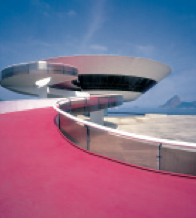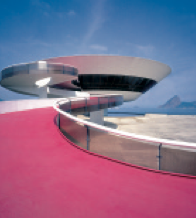Oscar Niemeyer
Fundación Telefónica Madrid
The exhibition presented at Fundación Telefónica in Madrid, in conjunction with the Fundación Cultural Hispano-Brasileña, is the well-deserved tribute to one of the most influential architects in the international context. This retrospective dedicated to Oscar Niemeyer (Rio de Janeiro, Brazil, 1907), who has been distinguished with the most important and prestigious international architectural awards, shows all his artistic facets and coincides with the upcoming inauguration of the Niemeyer Center in Avilés, the only work in Spain designed by the architect.

Particularly noteworthy is the curatorial task developed by Lauro Cavalcanti, who has engaged in a careful planning of the show, a show which, in view of the evident impossibility of showcasing the entire production of the Carioca architect, is more than satisfactory in terms of the material exhibited and the audio-visual presentations. Also important is the didactic plane, which is fundamental to verify, at each stage, the evolution of Niemeyer’s work along the more than seven decades during which he has devoted himself to architecture.
The itinerary of this exhibition is biographically oriented, which allows visitors to enter into the different worlds of this architect who was a pioneer in experimenting with constructivism. The tour of the show, comprised of eighteen models of Niemeyer’s most representative projects, twenty-one drawings and around fifty sketches, is completed with the presentation of books, photographs, audio-visual material, and a sofa and a sculpture, both designed by the architect. In this way, the exhibition alternates his best known facets with those that have been devoured by his fame as an architect. Thus, with each step we take, we revisit the project that catapulted him to fame, the lay-out of Brasilia based on the plan by Lúcio Costa, and we can appreciate Niemeyer’s social and political commitment, materialized through such projects as the design of the headquarters of the French Communist Party in Paris, or that of the University of Constantine,
in Algiers. The visitor walks amidst photographic legacies and models of his fundamental works, from the headquarters of the Italian publishing company, Mondadori, to the acclaimed Museum of Contemporary Art in Niteroi, considered by many to be his masterpiece, and one may perceive the direct and constant implication of the Brazilian architect in each of his projects.
The exhibition assigns a fundamental role to the curves which fascinated Niemeyer, and which he found in his country’s exuberant nature and in the women who had an important place among his commitments in life. But it also makes a necessary wink to allow us to discover his versatility, which led Niemeyer to develop an interesting pictorial production and approach literature,and this may be another strong point in this retrospective.




